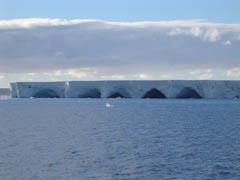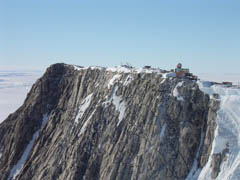|
“Exploration
is the physical expression of the Intellectual Passion.”
— Apsley
Cherry-Garrard
“Why Antarctica?” Cherry-Garrard’s
reason works for me. Many
years ago my interest was piqued by stories from the “heroic age” of
Antarctic exploration. I
used to daydream about taking a dog sled journey around the Ross Ice
Shelf. Alas, dogs are no
longer allowed on the continent – snowmobiles are more environmentally
friendly!
Most visitors travel from Argentina and see the Antarctic peninsula.
However, the historic explorers came to McMurdo Sound, in the
Ross Sea, which is closer to New Zealand and Australia.
There are only two ships that regularly visit these waters –
the 112 passenger Kapitan Khlebnikov and the 48 passenger Spirit of
Enderby. Both are Russian
ships, with Russian crews, catering to tourists following the collapse
of the Soviet Union. The
former is a world class icebreaker, which I chose for this trip.
And, a good thing too, as ice conditions in McMurdo Sound have
been thwarting the Enderby’s attempt to reach some of the historic
huts in that area.
The
White Continent
Our first landing on the continent was at Cape Adare.
We used zodiac boats and beached right alongside the world’s
largest Adelie penguin rookery, comprised of some quarter million
breeding pairs of birds. Yes,
penguins are birds. This is
also the site of the first structure built in Antarctica, a hut from
Carsten Borchgrevink’s 1899 expedition.
I was immediately struck by the noise.
We were there late in the breeding season, when the chicks were
about two‑thirds the size of the adults, and still dependent on
them for food. A parent
arrives on land and heads to the nesting spot, calling out for its
chicks. The chicks call
back, and amidst the many thousands of squawking birds, they recognize
one another! The parent
regurgitates food into the chick’s mouth and then heads back into the
water to get more food.
Anywhere you turn, you will also see lots of dead penguins, or bits of
them. Skuas patrol the area, looking for dying penguins to eat, but
there must be many that escape their attention. With this extremely dry climate, if the remains are left,
they will toughen up quickly and lie about for many weeks, months or
years. It really brings
home the nature of their life and death struggle to survive in this
harsh environment.
Iceberg
B-15A and McMurdo Sound
From Cape Adare, we entered the Ross Sea and cruised south until we
reached the awesome iceberg B-15A.
This iceberg is a behemoth, almost half the size of the Grand
Canyon.
We rounded B-15A and entered McMurdo Sound.
Dominating the landscape is Mt. Erebus, Antarctica's most active
volcano, which rises to an elevation of 12,447 feet.
It’s not as tall as Mt. Humphreys, but, then, we are looking up
at it from sea level! Clearly
visible was a trail of smoke and gas emerging from the summit caldera,
giving the scene a primordial feel.
The
Dry Valleys
Across the sound are the famous Dry Valleys, perhaps the driest, coldest
place on Earth. It is a
landscape that is more like Mars than it is like the rest of our planet.
This was our first landing by helicopter and we were packed in
like sardines. The effect
is enhanced because we are all wearing bulky clothing, emergency life
vests and carrying camera equipment.
We were able to spend some time walking through the rock-strewn
wilderness and alongside a small lake at the base of a glacier.
Having hiked many thousands of miles in the Grand Canyon, I would
have liked to strap on a pack and head for the horizon.
The
Historic Huts
It was especially rewarding to visit the historic huts of Robert Falcon
Scott and Ernest Shackleton. Their
expeditions attempted to be the first to reach the South Pole.
Shackleton got to within 97 miles, while Scott reached the pole
only to perish on the return. Even
so, Scott was not the first, as the Norwegian explorer, Roald Amundsen,
had beaten him to the pole by a month.
The huts are still in good shape, and active efforts are being made to
preserve them. All have
supplies that were left behind. In
Shackleton’s hut, the two sledges used on the polar journey are still
wedged into the rafters. Also remaining are boxes of biscuits, jars of table salt and
tins of cocoa, corn flour and mustard.
Just a few miles south is Scott’s 1911 hut.
Besides the bunks, odd clothing and food stores left behind,
there was a box of broken penguin eggs and strips of seal blubber nicely
stacked in the covered porch. One
item especially stands out – the table that fills up the middle of the
hut. This has been made
famous in a photo taken during the winter of 1911, with all the men
sitting around it, celebrating Scott’s birthday.
It is with some reverence that we moved about the hut, remarking
in hushed tones on the men who would journey out into this inhospitable
land. On a nearby hill I
sat for about a half hour, looking out over the hut and the sea ice, and
daydreaming. The sense of
history is palpable and one is easily overtaken by raw emotions as your
mind drifts back to those times.
Scott’s 1901 hut is at the site of the main American base in
Antarctica, McMurdo Station. This
hut was not lived in – Scott and his men wintered over on their ship
– but there are still supplies remaining inside.
A half mile away, on the other side of McMurdo Station, is
Observation Hill, which provides a marvelous panorama of the surrounding
area. I was able to hike up
to the top, where there is a cross, erected in 1913, commemorating the
loss of Captain Scott and his party.
Research
Stations in Antarctica
We visited three working research stations – McMurdo Station, New
Zealand’s Scott Base and the Italian station at Terra Nova Bay.
All are active and involved in a variety of projects.
We also visited Leningradskaya, a Soviet station abandoned in
1993. It is difficult to
get to – we had to fly over 25 miles of ice, even though the station
is located on the coast and we were there at the height of summer.
It has been just three years since the first tourists visited
this station. Empty
barrels, unused vehicles, a dozen buildings and a Russian sign pointing
to distant places around the world mark this site.
Back
to the Real World
Leningradskaya
was our last visit on the continent.
As we crunched our way through the ice northward, night once
again returned. A couple of days out we saw the Aurora Australis, stretching
from horizon to horizon. Soon
enough, we were in rougher seas with overcast skies, as if passing from
one world, which Amundsen described as looking “like a fairytale,”
and back into another. Waking
up on the morning of our twenty-fourth day aboard ship and seeing the
harbor of Hobart, Tasmania, I did have to wonder if the trip had been
real. |




